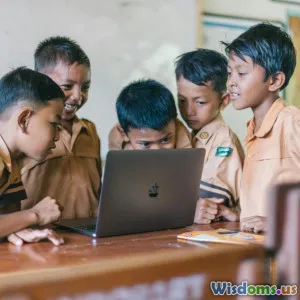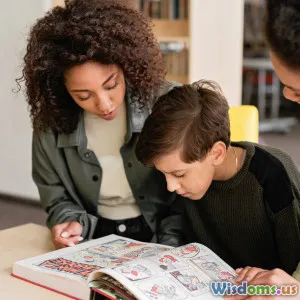
Fostering Collaboration in Learning Environments
8 min read Explore effective strategies for fostering collaboration in modern learning environments. (0 Reviews)
Fostering Collaboration in Learning Environments
In today’s interconnected world, the nature of learning is evolving dramatically. Gone are the days of isolated learning, where students and educators alike function within silos. In this article, we will delve into innovative strategies for fostering collaboration in learning environments, enhancing educational outcomes, and empowering students with skills crucial for the future.
The Importance of Collaboration in Learning
Collaboration is a multifaceted approach that enriches the learning experience. According to research from the American Psychological Association, cooperative learning enhances students’ academic performance and promotes higher-order thinking skills. Collaboration nurtures critical interpersonal skills that are necessary for both personal and professional success.
For example, a study from the University of Minnesota revealed that students engaged in collaborative learning perform significantly better academically and cultivate social skills that are essential for their careers. It allows learners to share diverse perspectives, leading to richer understanding and innovation.
The Role of Technology in Collaborative Learning
1. Digital Platforms for Collaboration
With advancements in educational technology, numerous platforms have emerged to facilitate collaboration. Tools like Google Workspace and Microsoft Teams enable students to work together on shared documents, conduct virtual discussions, and manage group projects seamlessly.
In a 2023 study conducted by the Institute of Education Sciences, schools that integrated technology effectively reported 30% higher levels of student engagement and collaboration. The introduction of collaborative tools not only aids in group activities but also allows students to communicate more efficiently, transcending geographical barriers.
2. Asynchronous and Synchronous Learning
A hybrid of asynchronous (self-paced) and synchronous (real-time) learning fosters collaboration by respecting the differing paces of individual learners while still allowing for group interaction. Platforms such as Edmodo and Slack cater to this, allowing discussion boards for brainstorming sessions that accommodate varying schedules.
These platforms also encourage sharing resources, enabling students to gather information together, resulting in a more dynamic learning experience. Utilizing Flipped Classrooms, where students learn new content online and engage in collaborative exercises during class, has successfully increased student engagement.
Personal Connections and Community Building
1. Develop a Collaborative Mindset
Creating a culture that values collaboration begins with developing a collaborative mindset at the school or institutional level. Educators must actively promote cooperative learning by modeling collaborative behavior in their teaching styles. According to Professor Ed Deci, a renowned psychologist, intrinsically motivated relationships are vital for student success. By emphasizing the value of working together toward common goals, educators can help students understand the significance of collaboration.
2. Community Engagement and Real-Life Projects
Intertwining learning with community engagement creates real-world applications of collaborative skills. Programs that encourage students to work on community projects not only foster collaboration but also instill a sense of responsibility and connection.
A prominent example is the Junior Achievement program, which pairs students with local businesses for mentorship opportunities. This initiative not only nurtures academic skills but fosters professional relationships, aiding the development of collaboration in practical contexts.
Tailoring Pedagogies to Foster Collaboration
1. Project-Based Learning
Project-based learning (PBL) drastically enhances collaborative opportunities. PBL encourages students to work in groups to solve complex problems or create tangible outcomes. According to a study by the Buck Institute for Education, PBL engages students more deeply in their learning and ensures higher retention of knowledge in collaborative frameworks, as they assume responsibility not just for their learning but also for their peers’.
For instance, an interdisciplinary project sends students conducting research on climate change, where they collaboratively analyze data across various subjects like science, geography, and technology, culminates in a presentation that synthesizes their learnings.
2. Differentiated Instruction
Acknowledging diverse learning styles and needs is crucial. By using differentiated instructional strategies, educators can create more inclusive collaboration. For instance, small-group breakouts allow students who are visual learners to create visuals, while auditory learners can lead discussions, ensuring everyone contributes in their comfort zone.
Measuring Collaboration in Learning
1. Feedback Loops
Creating a system for feedback is essential for fostering collaboration. Regular assessments of group work, alongside peer reviews, instill a sense of accountability and provide insights into cooperative efforts. Tools like Peergrade can streamline this process by allowing students to provide feedback on team contributions.
2. Self-Assessment and Reflection
Encouraging self-reflection serves to solidify collaborative experiences. Facilitate conversations where students can analyze what they enjoyed and what faced challenges in collaborative settings. Gathering such information helps refine future projects and frameworks used.
Challenges in Fostering Collaboration
1. Resistance to Change
Change is often met with resistance, especially in established educational institutions. Educators might have familiar teaching methods resisting new collaborative approaches, which can impede progress. Addressing these concerns through professional development workshops emphasizing the benefits of collaboration can build trust and enthusiasm for innovative techniques.
2. Digital Divide
While technology enhances collaboration, it also raises questions related to access. Digital inequality can create barriers for students lacking access to the internet or devices they need for collaborative learning, perpetuating educational gaps. Schools must work to ensure equity by investing in resources that make digital collaboration inclusive for all students.
Conclusion
Fostering collaboration in learning environments is essential in preparing students for success in an increasingly collaborative world. By leveraging technology, promoting community engagement, tailoring pedagogies, and measuring collaborative efforts effectively, educational institutions can cultivate skilled, adaptable learners. Recognizing and overcoming challenges along the way will ensure that collaboration becomes an integrated aspect of education, shaping future generations likely to work successfully in teams, inspiring creativity and innovation.
In the end, fostering a culture of collaboration is not just about training students to work together but empowering them to thrive in an interconnected world.
Rate the Post
User Reviews
Popular Posts





















